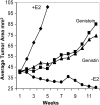Is soy consumption good or bad for the breast?
- PMID: 20980638
- PMCID: PMC2981011
- DOI: 10.3945/jn.110.124230
Is soy consumption good or bad for the breast?
Abstract
Genistein in soy activates estrogen receptor (ER)-α and ERβ and acts as an estradiol in multiple target tissues. Because estrogens increase breast cancer risk and genistein promotes the growth of ER-positive human breast cancer cells, it has remained unclear whether this isoflavone or soy is safe. Results reviewed here suggest that women consuming moderate amounts of soy throughout their life have lower breast cancer risk than women who do not consume soy; however, this protective effect may originate from soy intake early in life. We also review the literature regarding potential risks genistein poses for breast cancer survivors. Findings obtained in 2 recent human studies show that a moderate consumption of diet containing this isoflavone does not increase the risk of breast cancer recurrence in Western women, and Asian breast cancer survivors exhibit better prognosis if they continue consuming a soy diet. The mechanisms explaining the breast cancer risk-reducing effect of early soy intake or the protective effect in Asian breast cancer survivors remain to be established. We propose that the reduction in risk involves epigenetic changes that result in alterations in the expression of genes that regulate mammary epithelial cell fate, i.e. cell proliferation and differentiation. Lifetime soy consumption at a moderate level may prevent breast cancer recurrence through mechanisms that change the biology of tumors; e.g. women who consumed soy during childhood develop breast cancers that express significantly reduced Human epidermal growth factor receptor 2 levels. More research is needed to understand why soy intake during early life may both reduce breast cancer risk and risk of recurrence.
Conflict of interest statement
Author disclosures: L. Hilakivi-Clarke and W. Helferich received travel costs and L. Hilakivi-Clarke, J. E. Andrade, and W. Helferich received an honorarium from a nonrestricted educational grant provided by Pharmavite LLC to Columbia University for the Soy Summit, which served as the basis for this article. The grant provided funding for the summit and also covered the cost of this journal supplement.
Figures



References
-
- Helferich WG, Andrade JE, Hoagland MS. Phytoestrogens and breast cancer: a complex story. Inflammopharmacology. 2008;16:219–26 - PubMed
-
- Medina D. Mammary developmental fate and breast cancer risk. Endocr Relat Cancer. 2005;12:483–95 - PubMed
-
- Henderson BE, Bernstein L. Endogenous and exogenous hormonal factors. : Harris JR, Lippman ME, Morrow M, Hellman S, Diseases of the breast. Philadelphia: Lippincott; 1996. p. 185–200
-
- Franke AA, Custer LJ. High-performance liquid chromatographic assay of isoflavonoids and coumestrol from human urine. J Chromatogr B Biomed Appl. 1994;662:47–60 - PubMed
-
- Mazur W, Fotsis T, Wahala K, Ojala S, Salakka A, Adlercreutz H. Isotope dilution gas chromatographic-mass spectrometric method for the determination of isoflavonoids, coumestrol, and lignans in food samples. Anal Biochem. 1996;233:169–80 - PubMed
Publication types
MeSH terms
Grants and funding
LinkOut - more resources
Full Text Sources
Medical
Research Materials

